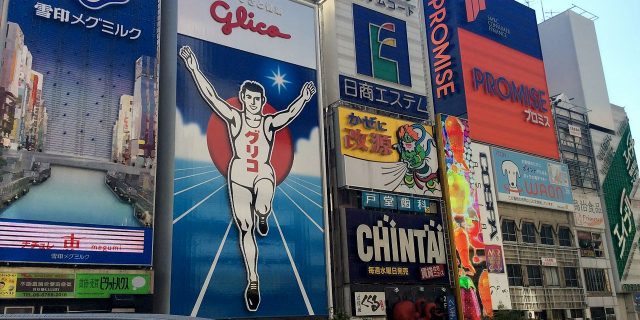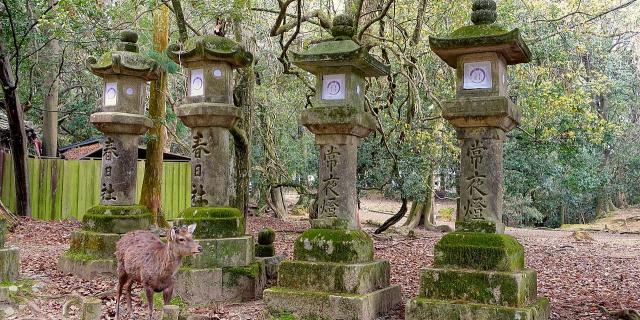Osaka Castle (大坂城 or 大阪城, Ōsaka-jō) is a Japanese castle in Chūō-ku, Osaka, Japan. The castle and fortress are one of Japan's most famous landmarks and it played a major role in the unification of Japan during the sixteenth century of the Azuchi-Momoyama period.
 Miniature model of the castle complex after the Tokugawa rebuilding
Miniature model of the castle complex after the Tokugawa rebuilding Ōte-mon Gate with moat in foreground
Ōte-mon Gate with moat in foreground Osaka Castle rampart in 1865
Osaka Castle rampart in 1865 Stone marking the place where Toyotomi Hideyori and his mother, Yodo-Dono, committed suicide after the fall of Osaka Castle
Stone marking the place where Toyotomi Hideyori and his mother, Yodo-Dono, committed suicide after the fall of Osaka CastleIn 1583 Toyotomi Hideyoshi commenced construction on the site of the Ikkō-ikki temple of Ishiyama Hongan-ji.[1] The basic plan was modeled after Azuchi Castle, the headquarters of Oda Nobunaga. Hideyoshi wanted to build a castle that mirrored Nobunaga's but surpassed it in every way: the plan featured a five-story main tower, with three extra stories underground, and gold leaf on the sides of the tower to impress visitors. In 1585 the Inner donjon was completed. Hideyoshi continued to extend and expand the castle, making it more and more formidable to attackers. In 1597 construction was completed and Hideyoshi died the year after. Osaka Castle passed to his son, Toyotomi Hideyori.
In 1600 Tokugawa Ieyasu defeated his opponents at the Battle of Sekigahara and started his own bakufu (i.e., shogunate) in Edo. In 1614 Tokugawa attacked Hideyori in the winter, starting the Siege of Osaka.[2] Although the Toyotomi forces were outnumbered approximately two to one, they managed to fight off Tokugawa's 200,000-man army and protect the castle's outer walls. Ieyasu had the castle's outer moat filled, negating one of the castle's main outer defenses.
During the summer of 1615, Hideyori began to restore the outer moat. Ieyasu, in outrage, sent his armies to Osaka Castle again, and routed the Toyotomi men inside the outer walls on June 4.
Osaka Castle fell to the Tokugawa clan, the Toyotomi clan perished, Hideyori and Yodo-dono committed seppuku and the castle buildings burned to the ground.[1]: 153
In 1620, the new heir to the shogunate, Tokugawa Hidetada, began to reconstruct and re-arm Osaka Castle. He completely buried the Toyotomi version of the castle with the new castle.[3] He assigned the task of constructing new walls to individual samurai clans. The walls built in the 1620s still stand today and are made out of interlocked granite boulders without mortar. Many of the stones were brought from rock quarries near the Seto Inland Sea and bear inscribed crests of the various families who contributed them.
Tokugawa also built a new elevated main tower, five stories on the outside and eight stories on the inside. Construction of the tenshu started in 1628 and was completed two years later, about the same time the rest of the reconstruction, and followed the general layout of the original Toyotomi structure.[1]: 153–157 However, it was built in a different part of the Honmaru (main bailey), as the base of the Toyotomi keep had actually been buried by the new Tokugawa version of the castle.[3]
In 1660, lightning ignited the gunpowder warehouse and the resulting explosion set the castle on fire. In 1665, lightning struck and burnt down the tenshu.[1]: 157
Kajisuke Nakama was one of the hatamoto guards that protected Osaka Castle. On 15 May 1740, when he was 25-year-old, he stole 4,000 ryō of gold inside. However, the crime was soon discovered by the shogunate, so he was arrested and confessed. Although he was a samurai, he was dragged around the city and sentenced to crucifixion in September. Later, this incident became a legend and the contents changed, so it is said that he was a thief who wanted the gold that Toyotomi Hideyoshi had dropped in the Kinmeisui Well.[4][5][6]
In 1843, after decades of neglect, the castle got much-needed repairs when the bakufu collected money from the people of the region to rebuild several of the turrets.
In 1868, Osaka Castle fell and was surrendered to anti-bakufu imperial loyalists. A number of the castle buildings were burned in the civil conflicts surrounding the Meiji Restoration.[1]: 157 The Honmaru Palace was lost during the Boshin War. In its place the Kishū Palace (紀州御殿 Kishū Goten) was moved here from Wakayama Castle to serve as an imperial state guest house, named later Tenrinkaku.[7][8][9][10]
Under the Meiji government, Osaka Castle became part of the Osaka Army Arsenal (Osaka Hohei Kosho) manufacturing guns, ammunition, and explosives for Japan's rapidly expanding Western-style military.[11]
In 1931, the ferroconcrete tenshu was built.[1]: 157
 Osaka castle grounds serving as a part of the Osaka Army Arsenal, June 1945
Osaka castle grounds serving as a part of the Osaka Army Arsenal, June 1945During World War II, the arsenal became one of the largest military armories, employing 60,000 workers.[11] American bombing raids targeting the arsenal damaged the reconstructed main keep and, on August 14, 1945, destroyed 90% of the arsenal and killed 382 people working there.
In 1995, Osaka's government approved yet another restoration project, with the intent of restoring the main keep to its Edo-era splendor. In 1997, restoration was completed. The keep is a concrete reproduction (including elevators) of the original and the interior is intended as a modern, functioning museum.
Located in the Nishinomaru was the former residence of the jōdai, who were officials. The residence was the second largest after the Honmaru Palace. North of it were a number of warehouses. The site is now a park. Next to it is the Osaka State Guest House and the Hōshō-an chashitsu.
































Add new comment